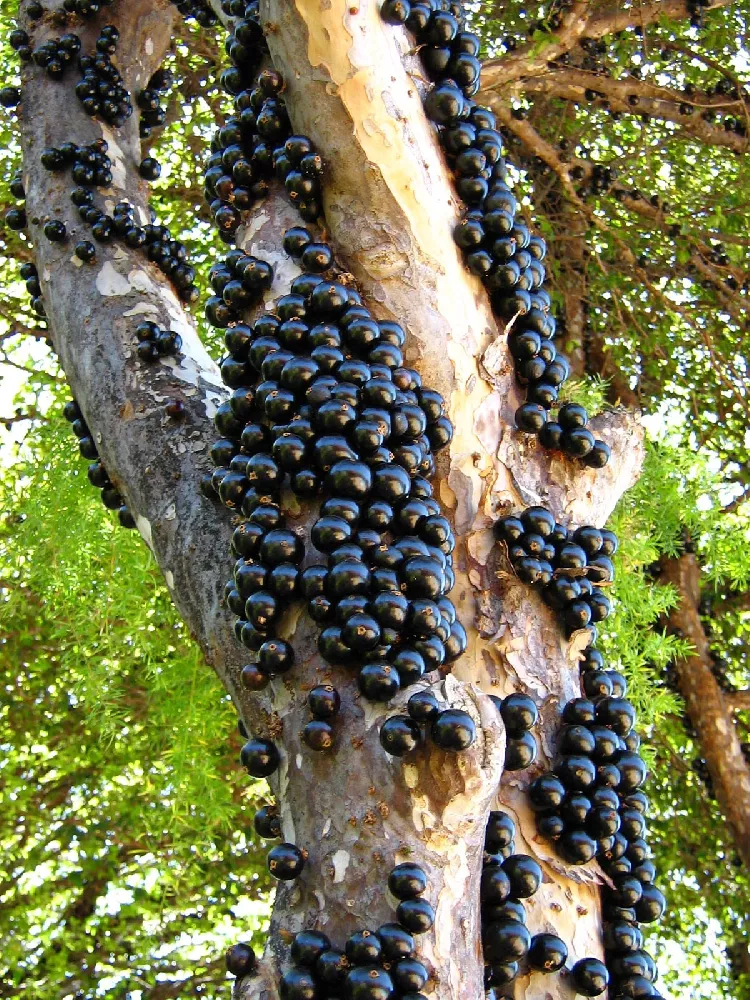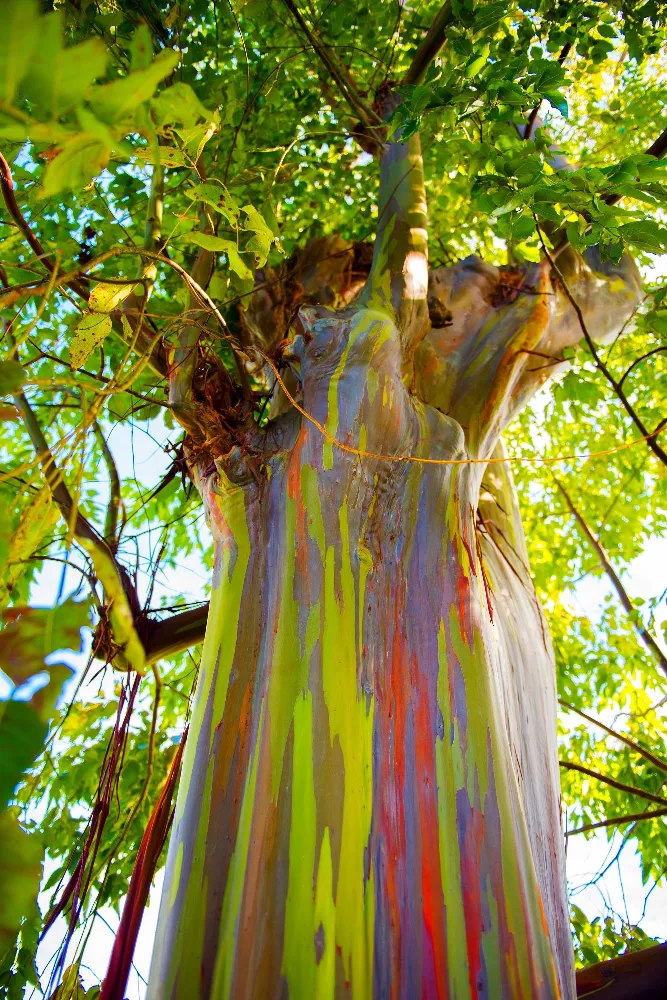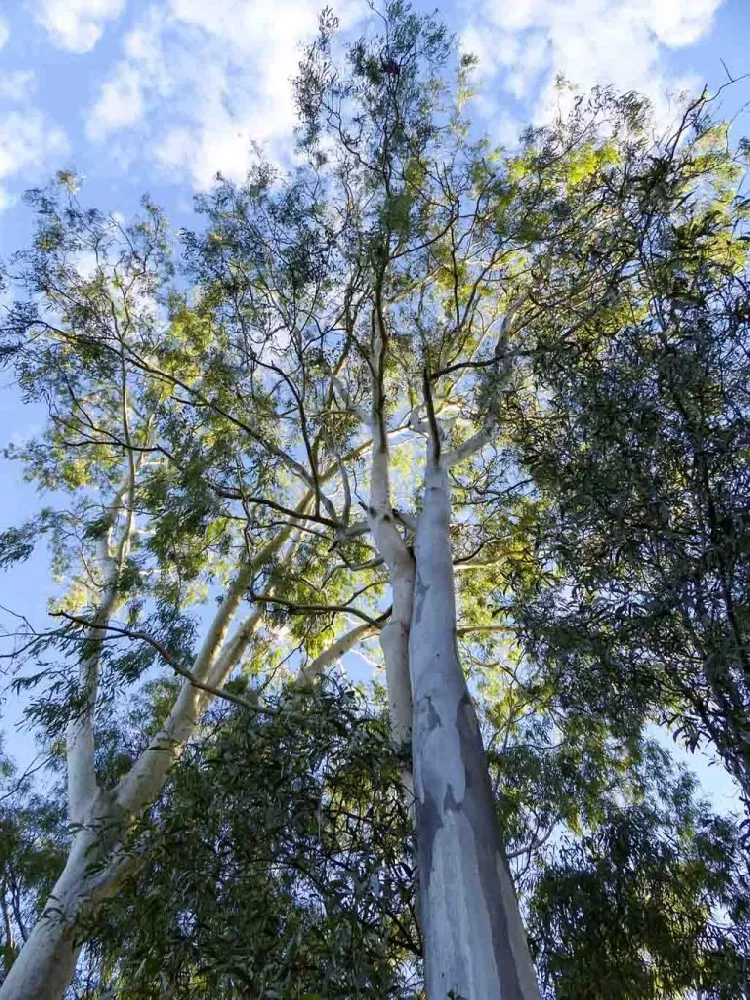- Home >
- Edible Plants >
- Jaboticaba Tree
Jaboticaba Tree for Sale - Buying & Growing Guide
Many gardeners grow the jaboticaba Tree, also known as Myrciaria cauliflora, for its fruits. But while these fruits have a distinct flavor that many love, the ornamental features of this plant deserve mention. Both the flowers and the fruits of the jaboticaba tree appear on the bark and cover most of the tree at certain parts of the year. This impressive effect creates intense visual appeal through multiple seasons. The bark itself is also interesting; it peels as it ages, revealing brighter bark below.
- Dark fruits cover the branches of this tree and have a strong flavor.
- White flowers are fuzzy and cover most of the bark.
- The jaboticaba tree has multi-colored bark.
Enter your zip code to find nearby stores that may carry this plant.
Plant Care
Sunlight

The jaboticaba tree survives in both full and partial sunlight conditions.
Watering
Its water needs are typically high. Monitor soil moisture and add water when the surface has become dry.
Fertilizing

Use an all-purpose fertilizer about three times per growing season.
Planting and Care
Planting instructions
The jaboticaba tree is not tolerant of frost but will grow in many different types of soil. When planting this tree, remove it from its container, then rough the root ball to loosen the roots. After removing the plant, place it in a hole that is as deep as the root ball is tall and at least twice as wide. Backfill with healthy soils and provide plenty of water after planting. As long as this plant receives full or partial sunlight, it should adapt well to its new growing location.
Watering and nutrients
Compared to many plants, the jaboticaba tree has high water needs. This also spreads its roots close to the surface of the soil, which is why it is essential to monitor the top layer of soil for moisture. When the top layer of soil has become dry, it is time to add more water for this plant. Jaboticaba trees also grow better when they receive regular feedings. Fertilization about three times per year with a balanced, all-purpose blend will make for the best results.
Pollination
Jaboticaba trees bloom with many flowers along their trunk and branches, which makes pollination easy to achieve. These plants are also self-fertile, meaning you need only one to produce fruits. However, if you grow more than one jaboticaba tree, you’ll open the opportunity for cross-pollination, which makes for better and more numerous fruits. Once this tree is old enough, it will begin producing fruits that are usually ready for harvest in spring but may appear at other times of the year as well.
Pruning
You can prune a jaboticaba tree to remove any branch that is broken, dead, or crossing. It also helps to remove stems and foliage that grow in the center of the tree. Jaboticaba trees bloom and fruit on their bark, and removing growth from those areas can encourage better flower and fruit production. These pruning practices are likely to improve your jaboticaba tree. However, there is a chance that your plant will grow well with minimal pruning each year.
Pests, diseases, and animals
As is true for many plants, the jaboticaba tree can run into problems with pests like aphids, nematodes, spider mites, and more. However, these infestations are often mild and are unlikely to kill this plant quickly. But while pest problems are not often pervasive, other problems can come up. One of the most prevalent issues for a jaboticaba tree is chlorosis, which causes yellowing leaves. This problem often happens when the soil has become more alkaline than it should be.
Harvesting
Jaboticaba trees will produce their largest harvests during the spring months of March and April. However, this plant can continue to offer additional harvest later in the year as well. When the jaboticaba tree is ready for harvest, you’ll see many fruits covering the bark. Those fruits should have a dark color and be slightly soft to the touch. Mature fruits may be nearly black and could show a somewhat marbled complexion on their exteriors.
Achieving maximum results
No one should grow a jaboticaba tree unless they are well prepared to harvest a lot of fruits. In some scenarios, a large jaboticaba tree can grow several hundred pounds of viable fruits in one year. However, it can take some time for this plant to start fruiting. After around five to nine years, the jaboticaba tree will reach a fruiting age, but until then, you will need to remain patient and stick to a consistent care routine.
FAQs
What does jaboticaba fruit taste like?
Jaboticaba fruits have a unique taste that people often compare to that of a grape. Other people describe the flavor as being similar to blueberries. However, there are a few different types of jaboticaba trees, each of which can have a different flavor profile. But no matter which type you have, the jaboticaba tree fruits you pick will be somewhat acidic and can add to many different dishes, including jams and juices.
Can jaboticaba trees grow in pots?
Jaboticaba trees can grow in containers, which is the only viable way to raise one for those who live in cooler climates. Since this species needs warmth year-round, you'll need to use a container to move the plant as needed to keep it alive. While jaboticaba trees can reach a considerable size when growing outdoors in their native range, they tend to be significantly smaller when they grow indoors or in a container.
What does jaboticaba mean in English?
Jaboticaba trees come from Brazil and have a common name that comes from an indigenous language from that region. The loose translation of this name means something along the lines of "like turtle fat." The best guess as to the origin of this name is that it refers to the fleshy nature of this fruit's pulp. In some instances, this tree may go by other common names, including the Brazilian grape tree.
Compare Similar Products
Customer Reviews
 Review
ReviewArrived safely and planted. We look forward to watching it grow and bear fruit.
 Jaboticaba Tree
Jaboticaba TreeThe plant I received was very well packaged with the size advertised and a few minors broken branches. The order was shipped fast and I recommend the seller. I am giving sometime to replant to allow it to get heathy and recover from shipping and the heat. The jaboticaba tree has now many new small branches showing signs of recovery and health.
 Jaboticaba Trees Rec'd
Jaboticaba Trees Rec'dTrees arrived in two boxes slightly maltreated by UPS, but after (essentially) repotting them, and liquid feed, they look great, and I look forward to the day when I taste the first fruit, all in due time.
You can't add more Product Name - Product size to the cart.
OK









